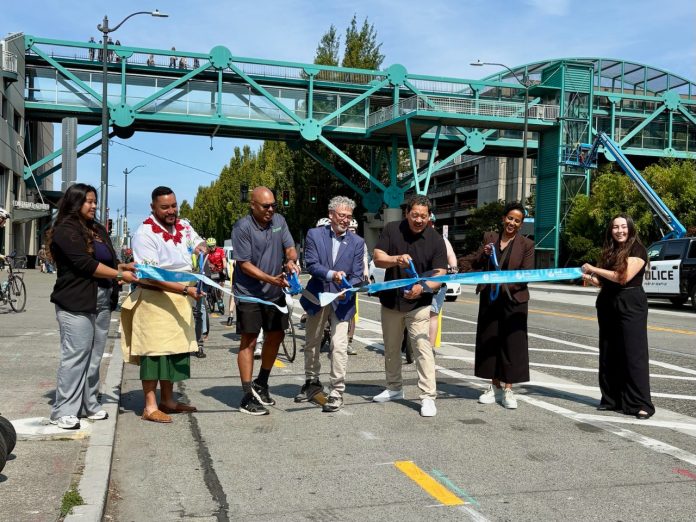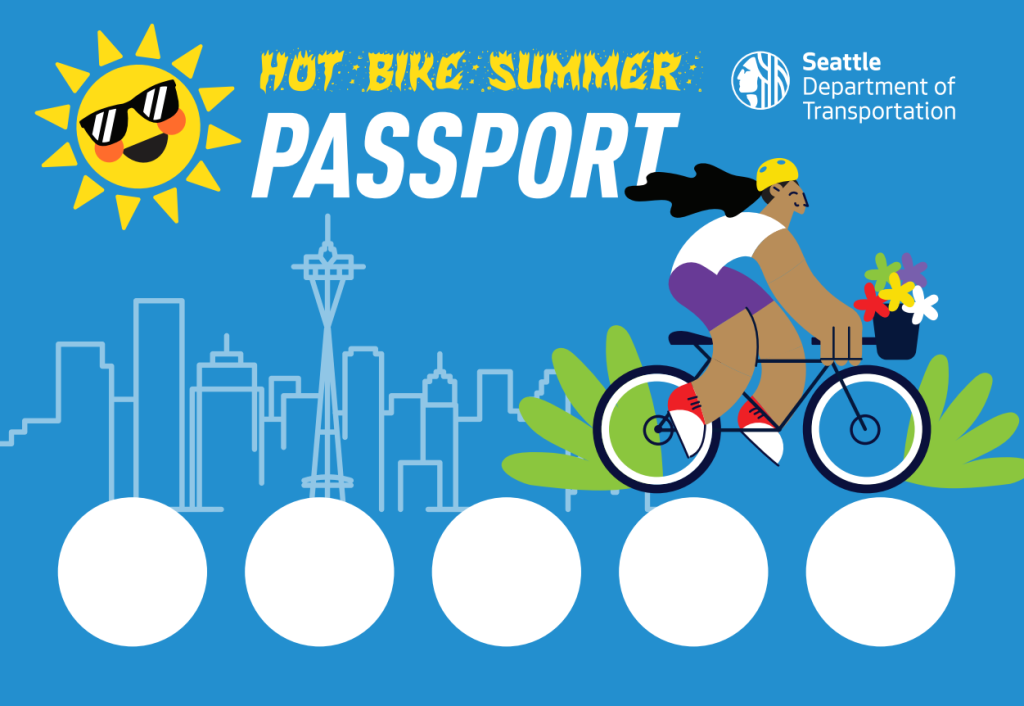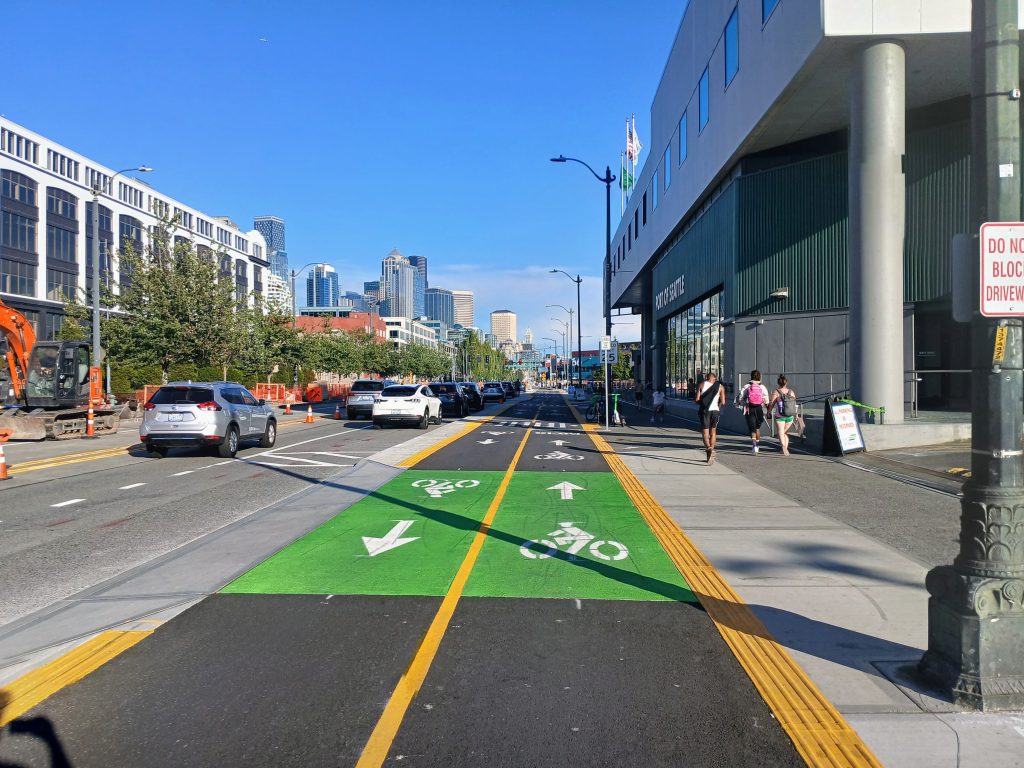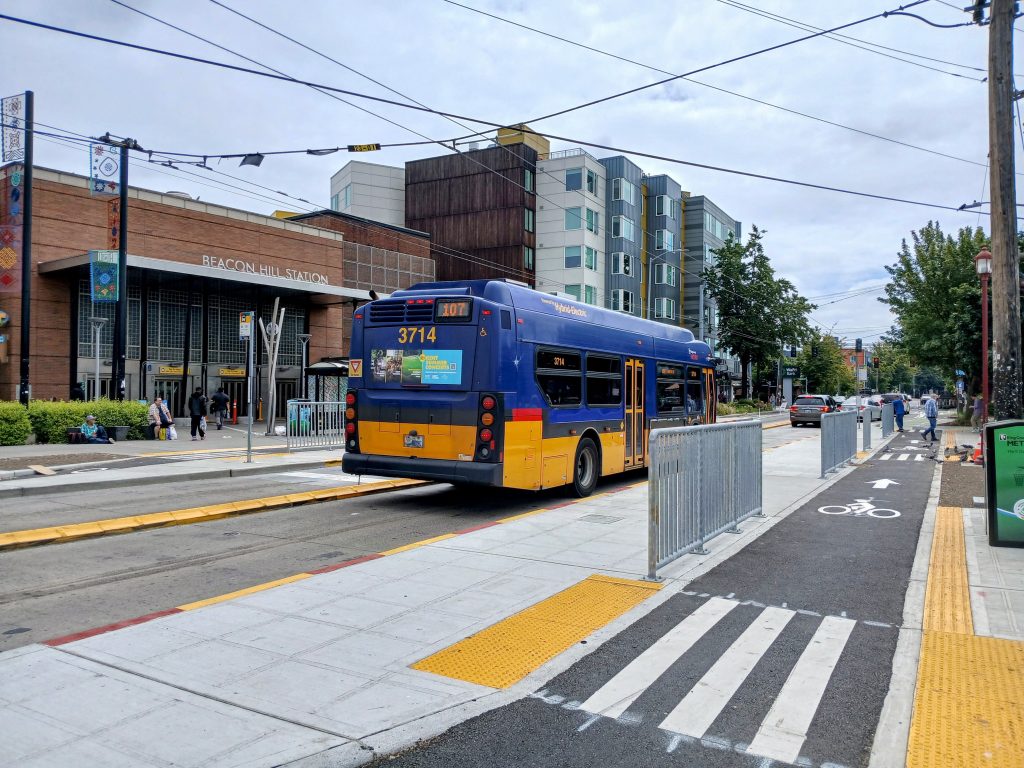
With five major bicycle safety projects either wrapping up or getting substantially completed around the city within the span of a few months, the Seattle Department of Transportation (SDOT) has officially declared it Hot Bike Summer in Seattle. By the time the sun sets on Hot Bike Summer, new connections will bridge major gaps in the city’s separated bike network, mostly on the South End, starting to balance out Seattle’s protected bike network, which is mostly focused in North Seattle and Downtown.
Hot Bike Summer officially kicked off on August 1, with a ribbon-cutting for the Alaskan Way Safety Project, bridging a final gap along the waterfront between the Seattle Aquarium and the Olympic Sculpture Park. A separate project from the newly completed bike path along the central waterfront, the grand opening nevertheless coincides well with the recent grand opening of Pier 58 and a planned all-day celebration on September 6 that marks the final end of over a decade of waterfront work.
Next will come the Beacon Avenue S & 15th Avenue S Safety Project, Georgetown to Downtown Safety Project, the Georgetown to South Park Trail, and East Marginal Way Corridor Improvement Project — not necessarily in that order. As part of the Hot Bike Summer promotion, dropping by a ribbon-cutting gets attendees a stamp on a passport. It’s mostly for fun and bragging rights, but the first 10 people to get three stamps on their passport can receive a $25 BikeLink bike parking card.

It’s been a very long road to get to the point of cutting the ribbon on all of these projects, and the City staff and construction crews executing on the vision for a more safe and connected bike network deserve their due credit. But it’s worth looking back on the driving forces that led to these projects in the first place, with every single one of the five preceding Bruce Harrell’s term as Mayor.
Much of the credit for Hot Bike Summer can be traced back to a 2019 resolution sponsored by then-transportation committee chair Mike O’Brien outlining a path to getting the bicycle master plan — approved five years earlier — back on track. In a high-profile reversal, Mayor Jenny Durkan had just cancelled plans for a protected bike lane on 35th Avenue NE in Wedgwood, and the city planned very few major bicycle safety projects in the coming years. That’s despite voters approving a major transportation levy in 2016 that promised to build 150 miles of bike facilities.
Without a change in course, Seattle City government was on track to run out of funding for bicycle connections while leaving Southeast Seattle completely disconnected from the rest of the city. Utilizing nearly $9 million in funding from the sale of a city-owned parcel in South Lake Union, the city council approved a road map for the years to come, with Alaskan Way, Beacon Avenue, Georgetown to Downtown, and the Georgetown-to-South Park Trail all included on the list, along with MLK Jr Way S and Fourth Avenue downtown.

That $9 million wasn’t anywhere near enough to advance all of the projects on the list, but it was seed money that allowed most of them to advance into design, and virtually every single project later qualified for federal funding that helped them turn into reality. The Move Seattle Levy’s bicycle safety goals themselves were a big reason that the Durkan Administration took the resolution’s direction seriously, and they provided guidance when there was an opportunity to use additional funds that became available.
Without that clear direction at a pivotal time, this year’s Hot Bike Summer might only be tepid at best.
East Marginal Way is the outlier among the five Hot Bike Summer projects, and has been in the works for even longer than the others. The idea of upgrading this fairly low traffic freight corridor through SoDo that also serves as a major access point for people on bikes to get to West Seattle has gone through four different mayors now. Mayor Mike McGinn allocated $200,000 to start design work back in 2013, with the project slowly advancing after receiving funding from the 2016 levy and getting a major federal grant in 2021.
At $43 million, East Marginal Way has been lauded as a gold standard when it comes to finding ways to accommodate both freight and bicycle traffic on a street. But it ultimately may ensure that SoDo sees few other separated bicycle routes on major corridors, if spending tens of millions to overhaul the entire street is seen as the only way to do it.
Of course, funding the Hot Bike Summer projects has only been one part of the winding road to completion. Building a safe bike route on Beacon Hill nearly fell apart multiple times after nearby residents came out strongly opposed to parking removal along 15th Avenue S. The Alaskan Way bike lane almost came with a permanent accommodation for cruise ships, requiring riders to cross the street twice to make the full connection. But the role of past leaders in making the first push can’t be ignored.

What comes after Hot Bike Summer? There are some projects in the pipeline, including a brief list that is set to be funded by the new Seattle Transportation Levy. But unlike in 2019, there’s no clear vision for which ones are the most important to get into the pipeline, nor a citywide conversation about what places are the most important to connect.
The Bicycle Master Plan has been replaced with the Seattle Transportation Plan, a document that tries to please everyone and ultimately presents no real road map for how the city will achieve its safety, mobility, and climate goals. Despite the fact that the city has a unified transportation plan for the first time ever, transportation planning is somehow more disjointed and rudderless than at any time in recent memory. There will clearly be upgrades here and there, but will the city truly build on all of the progress that has been made over the past 10 years? Right now, it doesn’t look like it.
Without reclaiming a bold vision for the future of the city’s all-ages-and-abilities bike network, Seattle is headed for a Cold Bike Winter.
Ryan Packer has been writing for The Urbanist since 2015, and currently reports full-time as Contributing Editor. Their beats are transportation, land use, public space, traffic safety, and obscure community meetings. Packer has also reported for other regional outlets including BikePortland, Seattle Met, and PubliCola. They live in the Capitol Hill neighborhood of Seattle.

